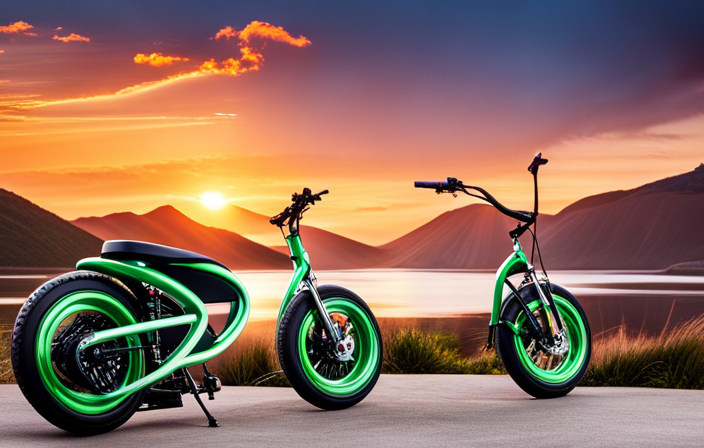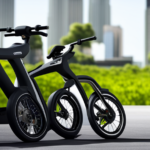As an avid electric bike rider, I’m always on the lookout for ways to maximize my riding experience. One key aspect that plays a crucial role in this is knowing how often to charge my electric bike.
Charging frequency is like the fueling strategy for traditional bikes – it ensures you have enough juice to go the distance. In this article, we will delve into the factors that affect battery life, manufacturer recommendations, and tips for prolonging battery health.
So, let’s dive in and unlock the secrets to getting the most out of your electric bike’s battery!
Key Takeaways
- Charging frequency for daily use and occasional use should be determined based on the manufacturer’s recommendations and monitoring battery levels.
- Regular charging after each ride or at 20-30% battery level helps maintain optimal charge level and prolongs battery life.
- Avoid overcharging to prevent heat buildup and decrease the ability of the battery to hold a charge.
- Seek professional assistance for battery maintenance and troubleshooting to address common battery issues and maximize battery performance.
Understanding Battery Types and Capacity
Understanding the battery types and capacity is essential in determining how often you’ll need to charge your electric bike. When it comes to battery maintenance, there are a few key considerations to keep in mind.
Firstly, it’s important to regularly check the battery for any signs of damage or wear. This includes inspecting the casing, connectors, and wiring. Additionally, keeping the battery clean and dry will help prolong its lifespan.
As for battery safety, always ensure that you are using the correct charger specifically designed for your electric bike’s battery. Using an incompatible charger can lead to overheating and potentially cause damage to the battery.
By being mindful of battery maintenance and safety, you can optimize the performance and longevity of your electric bike’s battery.
Now let’s delve into the factors that can affect battery life.
Factors Affecting Battery Life
To prolong your battery life, make sure you avoid excessive usage and maintain proper charging habits.
Several factors can affect the charging speed of your electric bike battery. First, the capacity of the battery plays a significant role. A higher capacity battery will generally take longer to charge compared to a lower capacity one.
Additionally, the charging method you use can also impact the speed. Fast chargers are designed to charge your battery quickly, but they can also generate more heat, which may reduce the overall battery life in the long run.
Speaking of temperature, it is crucial to note that extreme heat or cold can affect the performance and lifespan of your battery. It is best to charge your electric bike battery at room temperature for optimal results.
Now, let’s move on to the manufacturer recommendations for charging your electric bike battery.
Manufacturer Recommendations
Following the manufacturer’s recommendations will help ensure the longevity and performance of your battery. Proper battery maintenance is crucial for its overall health management.
To start, make sure to charge the battery fully before its first use, as this will help activate its cells and optimize its capacity. It is also important to avoid overcharging, as this can lead to decreased battery life.
Regularly cleaning the battery terminals with a soft cloth and ensuring they are free from dirt and corrosion will also contribute to better performance. Additionally, storing the battery in a cool and dry place when not in use will help prolong its lifespan.
By following these guidelines, you can maintain the health of your battery and maximize its efficiency.
Now, let’s move on to monitoring battery levels to ensure optimal usage.
Monitoring Battery Levels
Monitoring battery levels is crucial to ensure that you have enough power for your needs. As an electric bike enthusiast, I understand the importance of keeping an eye on battery levels to avoid running out of juice in the middle of a ride. To help you understand the significance of battery monitoring, here are some key points to consider:
-
Battery level indicators: Most electric bikes come equipped with battery level indicators, which display the remaining charge on your battery. These indicators can be easily accessed on the bike’s display panel or through a smartphone app.
-
Regular monitoring: It is important to regularly check your battery level indicators to ensure that you have sufficient power for your intended ride. This will help you plan your routes accordingly and avoid unexpected battery drain.
Now that we understand the significance of monitoring battery levels, let’s delve into the next section about the charging frequency for daily use. By following the recommended charging practices, you can optimize the lifespan of your battery and ensure a reliable riding experience.
Charging Frequency for Daily Use
Charging your battery daily is essential to maintain its lifespan and ensure a reliable experience. Proper battery charging not only extends the overall lifespan of your electric bike battery but also improves its performance. By following a regular charging routine, you can avoid premature battery degradation and maximize its longevity.
To emphasize the importance of daily charging, here is a table highlighting the benefits:
| Benefits of Daily Charging |
|---|
| 1. Maximizes battery lifespan |
| 2. Ensures consistent performance |
| 3. Reduces the risk of battery damage |
| 4. Enhances overall battery health |
| 5. Provides a reliable riding experience |
Charging Frequency for Occasional Use
When it comes to charging my electric bike for occasional use, I have found that charging it every few days is sufficient to maintain a good battery life. I have learned that overcharging can be detrimental to the battery’s overall health, so I make sure to avoid leaving it plugged in for extended periods of time.
Charging every few days
To keep your electric bike running smoothly, you’ll want to make sure you charge it every few days. Consistently charging your bike’s battery is crucial for maintaining its performance and longevity. Here are a few key reasons why charging every few days is important:
-
Battery charging frequency: Charging your bike’s battery every few days helps to ensure that it remains adequately charged and ready for use whenever you need it.
-
Battery charging time: Regular charging prevents the battery from fully depleting, which can lead to a longer charging time when you eventually do charge it.
-
Battery health: Charging your bike’s battery frequently helps to maintain its overall health and capacity, allowing it to provide optimal power and range.
-
Convenience: By charging your electric bike every few days, you can avoid unexpected situations where the battery runs out and you’re left stranded.
-
Long-term battery life: Regular charging can help extend the lifespan of your bike’s battery, ensuring that it serves you well for a longer period of time.
By understanding the importance of charging every few days, you can keep your electric bike in top shape and ready to ride whenever you want.
Now, let’s explore how to avoid overcharging your battery.
Avoiding overcharging
When it comes to charging my electric bike, I’ve learned that avoiding overcharging is crucial for maintaining the battery’s lifespan and charging efficiency. Overcharging occurs when the battery remains connected to the charger even after it has reached its full capacity. Not only does this waste electricity, but it can also lead to decreased battery performance over time.
To prevent overcharging, I make sure to disconnect the charger as soon as the battery is fully charged. Most electric bikes come with a built-in charging system that automatically stops the charging process once the battery is full, which is a convenient feature. By being mindful of overcharging, I can extend the overall lifespan of my battery and ensure that it operates at its optimal level.
Now, let’s explore some helpful tips for charging an electric bike during extended storage without causing any damage.
Charging Tips for Extended Storage
If you’re planning on storing your electric bike for an extended period, you should make sure to follow these charging tips.
First, when charging during travel, it’s important to use a reliable charger that is compatible with your bike’s battery. This will ensure a safe and efficient charging process.
Additionally, if you have access to solar charging options, take advantage of them. Solar panels can harness the power of the sun to charge your electric bike, providing a sustainable and eco-friendly charging solution. By utilizing solar energy, you can reduce your dependence on traditional electricity sources.
Transitioning into the next section, it’s also crucial to consider the charging time and duration to optimize the battery’s lifespan and performance.
Charging Time and Duration
When it comes to charging electric bike batteries, it’s important to know the average charging time for different battery capacities. This ensures that you can plan your charging schedule accordingly and avoid any unnecessary downtime.
Additionally, it’s crucial to avoid overcharging or undercharging as this can affect the overall lifespan and performance of the battery.
Average charging time for different battery capacities
To determine the average charging time for your electric bike with different battery capacities, you’ll need to consider the specific specifications of each battery. The charging speed of the battery is a crucial factor in determining the charging time. Generally, batteries with higher capacities take longer to charge compared to those with lower capacities.
Additionally, the temperature also plays a significant role in the charging time. Cold temperatures can slow down the charging process, while hot temperatures can speed it up. It is important to note that extreme temperatures can negatively impact the battery’s overall lifespan. Therefore, it is essential to find a balance between charging efficiency and battery health.
Now that we understand the average charging time, let’s delve into the next section about the importance of avoiding overcharging or undercharging.
Avoiding overcharging or undercharging
Finding the right balance between charging your battery too much or too little is crucial for maintaining its overall health and longevity. When it comes to optimizing battery lifespan, avoiding overcharging and undercharging is key. Here are some best charging practices to ensure you get the most out of your battery:
-
Charge your battery regularly: Regular charging helps maintain the optimal charge level and prevents deep discharges.
-
Avoid overcharging: Once your battery reaches its full capacity, unplug it to prevent overcharging, which can lead to decreased battery life.
-
Don’t let your battery drain completely: While it’s important to avoid overcharging, it’s equally important to avoid deep discharges, as they can shorten battery lifespan.
-
Use the right charger: Using the manufacturer-recommended charger ensures proper voltage and current levels for safe and efficient charging.
By following these tips, you can maximize your battery’s lifespan and performance.
Transitioning into the subsequent section about portable charging options, let’s explore how you can charge your battery on the go.
Portable Charging Options
When it comes to keeping my electric bike charged on the go, I always make sure to carry a portable charger with me. This way, I can easily plug it into my bike whenever I need a quick boost of power while I’m out and about.
Additionally, I also take advantage of charging stations or outlets in public spaces whenever they are available. It provides a convenient and reliable option for recharging my electric bike.
Carrying a portable charger for on-the-go charging
Carrying a portable charger is essential for quickly and conveniently charging your electric bike on-the-go. Not only does it offer convenience, but it also provides a backup charging option when other methods are not available.
Portable chargers come with a variety of benefits, including portability, versatility, and compatibility. They are lightweight and compact, making them easy to carry in your backpack or bike bag. Additionally, these chargers can be used with various types of electric bikes, making them a versatile option for any model.
When alternative charging methods such as using charging stations or outlets in public spaces are not accessible, having a portable charger ensures that you can still charge your electric bike wherever you are.
Using charging stations or outlets in public spaces
Using charging stations or outlets in public spaces can be a convenient way to power up your e-bike while you’re out and about.
When it comes to charging options, there are a few things to consider. First, check if the charging station or outlet is compatible with your e-bike’s charging specifications. Some stations may only support specific charging connectors or voltages.
Additionally, it’s important to factor in the cost considerations of using public charging stations. While some may offer free charging, others may require payment or a membership fee.
It’s also worth noting that charging times can vary depending on the charging station’s power output.
With these considerations in mind, utilizing public charging options can help ensure that your e-bike is always ready to ride.
When it comes to battery maintenance and care, there are a few steps you can take to prolong its lifespan.
Battery Maintenance and Care
When it comes to maintaining and caring for my electric bike battery, there are two key points that I always keep in mind.
Firstly, I make sure to regularly clean and protect the battery to prevent any dirt or debris from causing damage or affecting its performance.
Secondly, I always check for any signs of damage or wear, such as cracks or leaks, as these can indicate potential issues that need to be addressed.
Cleaning and protecting the battery
To keep your electric bike’s battery in good condition, it’s important to regularly clean and protect it. Here are some steps to follow for proper battery maintenance and care:
-
Use a clean cloth or sponge to wipe down the battery and remove any dirt or debris.
-
Avoid using harsh chemicals or abrasive materials that could damage the battery casing.
-
Apply a thin layer of battery protectant or corrosion inhibitor to prevent rust and corrosion.
-
Keep the battery dry and away from extreme temperatures, as moisture and heat can damage the battery cells.
-
Store the battery in a cool and dry place when not in use to prolong its lifespan.
By regularly cleaning and protecting your electric bike’s battery, you can ensure its longevity and optimal performance.
Now, let’s move on to checking for any damage or wear on the battery.
Checking for any damage or wear
Now, let’s see if there’s any damage or wear on the battery. Battery inspection is an essential part of the maintenance checklist for electric bikes. By regularly checking for any signs of damage or wear, you can ensure the longevity and performance of your battery. Here is a table summarizing the key aspects to inspect:
| Aspect | What to Look for | Action Required |
|---|---|---|
| Exterior | Cracks, dents, or corrosion | Replace if necessary |
| Connections | Loose or frayed wires | Tighten or replace connections |
| Terminals | Corrosion or buildup | Clean with a solution of baking soda |
| Voltage | Abnormal voltage readings | Consult a professional if necessary |
| Capacity | Reduced range or power output | Consider replacing or upgrading the battery |
Optimal Charging Techniques
You should always use a high-quality charger and avoid overcharging your electric bike for optimal battery life. Maximizing the lifespan of your battery is crucial to ensure a longer-lasting and efficient ride.
Here are three efficient charging techniques to help you achieve this:
-
Charge regularly: It’s important to maintain a consistent charging routine for your electric bike. Charging after each ride or when the battery level drops to around 20-30% helps prevent deep discharges, which can negatively impact battery health.
-
Avoid overcharging: Overcharging your electric bike can lead to excessive heat buildup, which can degrade the battery over time. Once your battery reaches its full capacity, disconnect it from the charger to prevent overcharging.
-
Store at optimal charge level: If you’re not using your electric bike for an extended period, it’s best to store the battery at around 50-60% charge. This helps to maintain the battery’s overall health and longevity.
Battery Health and Replacement
When it comes to electric bike batteries, it’s important to monitor their performance over time. This can be done through various methods. One method is checking the battery voltage. Another method is checking the battery capacity. Additionally, you can check the overall health of the battery. By keeping an eye on these factors, you can determine when it’s time to replace the battery. This will ensure optimal performance for your electric bike.
Monitoring battery performance over time
Monitoring the battery’s performance over time can help ensure the electric bike remains efficient. Proper battery maintenance is crucial for optimal performance and longevity. Here are some key points to consider:
-
Regular charging: Charge the battery after each ride, even if it’s not fully depleted. This helps maintain the battery’s overall health and capacity.
-
Battery temperature: Keep an eye on the battery’s temperature during charging and usage. Extreme temperatures can affect its performance and lifespan.
-
Battery voltage: Monitor the voltage levels regularly to ensure it’s within the recommended range. Low voltage may indicate a need for charging or potential battery issues.
-
Battery cycles: Keep track of the number of charge cycles the battery goes through. Most batteries have a limited number of cycles before they should be replaced.
Knowing when to replace the battery
After monitoring the performance of my electric bike’s battery over time, I have become well-versed in the signs of battery deterioration and when it’s time for a replacement.
One of the most helpful features that electric bike manufacturers provide is battery replacement indicators. These indicators can come in the form of LED lights or digital displays that show the remaining battery capacity. As the battery deteriorates, these indicators will gradually show less and less capacity, indicating the need for a replacement.
However, there are other signs to look out for as well. These include a significant decrease in the bike’s range, longer charging times, and a decreased ability to hold a charge. By being aware of these indicators and signs, I can ensure that I replace my electric bike’s battery at the right time, keeping my bike running smoothly and efficiently.
Speaking of efficiency, let’s now explore some ways to prolong the battery life without compromising performance.
Prolonging Battery Life
To prolong the battery life of your electric bike, you should avoid fully depleting it before recharging. This is because lithium-ion batteries, which are commonly used in electric bikes, have a limited number of charge cycles. By frequently fully depleting the battery, you are putting more stress on it and reducing its overall lifespan.
Instead, it is recommended to charge your electric bike battery regularly, even if it is not fully depleted. This is known as ‘topping off’ the battery and helps to maintain its optimal charge level. Additionally, it is important to use the correct battery charging techniques and follow battery charging safety guidelines provided by the manufacturer.
By taking these precautions, you can ensure that your electric bike’s battery lasts longer and performs at its best.
Now, let’s move on to maximizing range and efficiency without compromising battery life.
Maximizing Range and Efficiency
One way you can maximize the range and efficiency of your electric bike is by adjusting your riding habits. By being mindful of how you ride, you can effectively extend your battery life and make the most out of each charge.
To maximize your battery lifespan, it’s important to avoid rapid acceleration and excessive speeds, as these actions drain the battery faster. Additionally, maintaining a consistent speed and avoiding unnecessary stops and starts can help conserve energy.
Another way to optimize your electric bike’s performance is by adopting efficient charging methods. This includes charging your battery fully before each ride and avoiding overcharging. It’s also recommended to use the manufacturer’s recommended charger and avoid using third-party chargers, as they may not provide the optimal charging voltage.
By implementing these riding habits and charging practices, you can greatly enhance the range and efficiency of your electric bike.
If you encounter any difficulties or need further guidance, seeking professional assistance is always a wise choice.
Seeking Professional Assistance
It’s always a good idea to seek professional assistance if you encounter any difficulties or need further guidance with your electric bike. When it comes to battery maintenance and troubleshooting common issues, the expertise of a professional can be invaluable. They have the knowledge and experience to diagnose and fix any problems that may arise with your electric bike’s battery.
In order to highlight the importance of seeking professional assistance, let’s take a look at a table depicting some common battery issues and their potential consequences:
| Issue | Consequence | Solution |
|---|---|---|
| Battery not charging | Limited riding range | Check charger connection |
| Rapid battery drain | Inability to complete rides | Inspect and replace faulty components |
| Battery not holding charge | Reduced overall battery life | Test and replace worn-out battery cells |
| Overheating battery | Risk of fire or explosion | Seek immediate professional help |
As you can see, these issues can have serious consequences if not addressed properly. Seeking professional assistance ensures that your electric bike’s battery stays in optimal condition, maximizing its performance and lifespan. Don’t hesitate to reach out to a professional if you need any help with your electric bike.
Frequently Asked Questions
How long does it take to fully charge an electric bike battery?
It typically takes around 4-6 hours to fully charge an electric bike battery. It’s important to find the optimal charging frequency to ensure the battery’s longevity and performance.
What is the average lifespan of an electric bike battery?
The average lifespan of an electric bike battery can vary depending on several factors, such as the quality of the battery, usage patterns, and maintenance. Factors affecting battery lifespan include average charging time and proper storage.
Can I overcharge my electric bike battery?
Yes, you can overcharge your electric bike battery if you don’t take the necessary charging precautions and practice proper battery maintenance. It’s important to follow the manufacturer’s guidelines to ensure the longevity of your battery.
Is it safe to charge my electric bike battery overnight?
Charging an electric bike battery overnight can pose potential fire hazards due to overcharging. Additionally, frequent overnight charging can negatively impact the overall performance and longevity of the battery, reducing its lifespan. It is recommended to avoid overnight charging for safety and battery health.
How often should I replace my electric bike battery?
You should replace your electric bike battery when you notice signs of a dying battery, such as decreased range or difficulty holding a charge. Regular electric bike battery maintenance is important to prolong its lifespan.
Conclusion
In conclusion, maintaining the optimal charging frequency for your electric bike is crucial for maximizing battery life and ensuring long-term efficiency. By understanding the different battery types and capacities, monitoring battery levels, and following manufacturer recommendations, you can prolong the lifespan of your battery and avoid unnecessary replacements.
Seeking professional assistance when needed and taking proactive steps to maximize range and efficiency will ultimately lead to a more enjoyable and sustainable biking experience. Remember, coincidences can often reveal hidden meanings, just like the coincidental connection between regular charging and a longer battery life.















